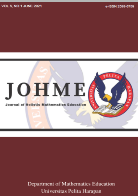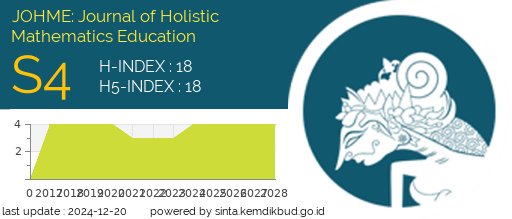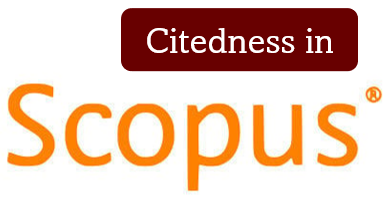EFEKTIVITAS PEMBELAJARAN DARING MATEMATIKA PADA MASA PANDEMI COVID-19 DI KOTA CILEGON [THE EFFECTIVENESS OF MATHEMATICS ONLINE LEARNING DURING THE COVID-19 PANDEMIC IN CILEGON CITY]
DOI:
https://doi.org/10.19166/johme.v5i1.3811Trefwoorden:
covid-19 pandemic, online learning, effectiveness of online learning, mathematics, pandemi covid-19, pembelajaran daring, efektivitas pembelajaran daring, matematikaSamenvatting
With the Covid-19 pandemic, the implementation of learning which is usually done face-to-face, now has to be done online as an effort to break the chain of the spread of Covid-19. The purpose of this study was to analyze the effectiveness of online learning during the covid-19 pandemic in the city of Cilegon. The research is a quantitative descriptive study in which the data collection technique uses a survey method in the form of a questionnaire given online. The first stage of data analysis conducted by the researcher is testing the validity and reliability of the instrument. Then the data obtained through the questionnaire was also carried out percentage analysis to determine the shape of the degree / level in order to be able to group it on the criteria of effectiveness. The research subjects were high school and vocational high school students or the equivalent. It is found that the results show an average of 60.6365% or fall into the category of quite effective.
BAHASA INDONESIA ABSTRACT: Dengan adanya pandemi covid-19, pelaksanaan pembelajaran yang biasanya dilakukan dengan tatap muka, sekarang harus dilakukan secara daring sebagai upaya memutus rantai penyebaran covid-19. Tujuan dari penelitian ini adalah untuk menganalisis efektivitas pembelajaran daring selama masa pandemi covid-19 di kota Cilegon. Penelitian termasuk kedalam penelitian deskriptif kuantitatif yang mana teknik pengumpulan datanya menggunakan metode survey berupa angket yang diberikan secara online. Tahapan pertama dari analisis data yang dilakukan oleh peneliti yaitu uji validitas dan reliabilitas instrumen. Kemudian data yang diperoleh melalui kuesioner dilakukan pula analisis persentasi untuk mengetahui bentuk derajat/tingkatannya agar dapat mengelompokkan pada kriteria keefektivan. Subjek penelitian adalah peserta didik tingkat SMA dan SMK atau sederajat. Didapatkan bahwa hasil menunjukkan rata-rata 60,6365% atau masuk kedalam kategori cukup efektif.
Referenties
Ali, M. (2009). Pendidikan untuk pembangunan nasional menuju bangsa Indonesia yang mandiri dan berdaya saing tinggi. Bandung, Indonesia: PT Imperial Bakti Utama.
Enriquez, M. A. E. (2014). Students’ perception on the effectiveness of the use of Edmodo as a supplementary tool for learning. DLSU Research Congress. Retrieved from https://www.academia.edu/25357970/Students_Perceptions_on_the_Effectiveness_of_the_Use_of_Edmodo_as_a_Supplementary_Tool_for_Learning
Erikanto, C. (2016). Teori belajar dan pembelajaran. Yogyakarta, Indonesia: Media Akademi.
Falahudin, I. (2014). Pemanfaatan media dalam pembelajaran. Jurnal Lingkar Widyaiswara, 4(1), 104-117. Retrieved from http://juliwi.com/published/E0104/Paper0104_104-117.pdf
Handarini, O. I., & Wulandari, S. S. (2020). Pembelajaran daring sebagai upaya study from home (SFH) selama pandemi covid-19. JPAP: Jurnal Pendidikan Administrasi Perkantoran, 8(3), 496-503. Retrieved from https://journal.unesa.ac.id/index.php/jpap/article/view/8503/4094
Hikmat, H., Hermawan, E., Aldim, A., & Irwandi, I. (2020). Efektivitas pembelajaran daring selama masa pandemi covid-19: Sebuah survey online. Retrieved from http://digilib.uinsgd.ac.id/30625/1/FISIP%20Kelompok%207.pdf
Ibadurrahman, M. A. (2020). Coronavirus asal usul, penyebaran, dampak, dan metode pencegahan efektif pandemi covid-19. Jakarta.
Iftakhar, S. (2016). Google classroom: What works and how. Journal of Education and Social Sciences, 3, 12-18. Retrieved from http://jesoc.com/wp-content/uploads/2016/03/KC3_35.pdf
Limbong, T., & Simarmata, J. (2020). Menentukan matakuliah yang efektif belajar daring (belajar dan ujian) dengan metode multi-attribute utility theory (MAUT). Jurnal RESTI: Rekayasa Sistem dan Teknologi Informasi, 4(2), 370-376. Retrieved from http://jurnal.iaii.or.id/index.php/RESTI/article/view/1851/240
Magdalena, I., Yulianti, D., Ningsih, D. A., & Ramadhania, P. R. (2020). Perkembangan teknologi dalam media pembelajaran online serta dampaknya di masa pandemi covid 19 di SDN Kosambi III Sukadiri. Edisi: Jurnal Edukasi dan Sains, 2(3), 375-386. Retrieved from https://ejournal.stitpn.ac.id/index.php/edisi/article/view/1011/703
Miswar, D., Yarmaidi, & Sasmita, E. (2016). Perbedaan penerapan model problem based learning pada hasil belajar geografi. Yogyakarta, Indonesia: Media Akademi.
Mulyasa. (2012). Praktek penelitian tindakan kelas. Bandung, Indonesia: PT Remaja Rosdakarya.
Mustakim. (2020). Efektivitas pembelajaran daring menggunakan media online selama pandemi covid-19 pada mata pelajaran matematika. Al Asma: Journal of Islamic Education, 2(1), 1-12. https://doi.org/10.24252/asma.v2i1.13646
Nurdin., & Anhusadar, L. (2020). Efektivitas pembelajaran online pendidik PAUD di tengah pandemi covid-19. Jurnal Obsesi: Jurnal Pendidikan Anak Usia Dini, 5(1), 686-697. https://doi.org/10.31004/obsesi.v5i1.699
Oktavian, R., & Aldya, R. F. (2020). Efektivitas pembelajaran daring terintegrasi di era pendidikan 4.0. Didaktis: Jurnal Pendidikan dan Ilmu Pengetahuan, 20(2), 129-135. https://doi.org/10.30651/didaktis.v20i2.4763
Rusman, D, K., & Riyana, C. (2013). Pembelajaran berbasis teknologi informasi dan komunikasi: Mengembangkan profesionalitas guru. Jakarta, Indonesia: Rajawali Pers.
Sicat, A. S. (2015). Enhancing college students’ proficiency in business writing via schoology. International Journal of Education and Research, 3(1), 159-178. Retrieved from https://www.ijern.com/journal/2015/January-2015/14.pdf
Trianto. (2009). Mendesain model pembelajaran inovatif progresif. Surabaya, Indonesia: Kencana.
Uno, H. B., & Lamatenggo, N. (2011). Teknologi komunikasi dan informasi pembelajaran. Jakarta, Indonesia: PT Bumi Aksara.
Yaumi, M. (2018). Media dan teknologi pembelajaran. Jakarta, Indonesia: Prenada Media Group.
Yuliana, Y. (2020). Corona virus diseases (Covid-19): Sebuah tinjauan literatur. Wellness And Healthy Magazine, 2(1), 187-192. https://doi.org/10.30604/well.95212020
Yusuf, H. M. (2004). Menyemai benih teknologi pendidikan. Jakarta, Indonesia: Prenada Media.
Zhafira, N. H., Ertika, Y., & Chairiyaton. (2020). Persepsi mahasiswa terhadap perkuliahan daring sebagai sarana pembelajaran selama masa karantina covid-19. Jurnal Bisnis dan Kajian Strategi Manajemen, 4(1), 37-45. Retrieved from http://jurnal.utu.ac.id/jbkan/article/viewFile/1981/1454##submission.downloads##
##submission.additionalFiles##
Gepubliceerd
Citeerhulp
Nummer
Sectie
Licentie
Authors who publish with this journal agree to the following terms:
1) Authors retain copyright and grant the journal right of first publication with the work simultaneously licensed under a Creative Commons Attribution License (CC-BY-SA 4.0) that allows others to share the work with an acknowledgement of the work's authorship and initial publication in this journal.
2) Authors are able to enter into separate, additional contractual arrangements for the non-exclusive distribution of the journal's published version of the work (e.g., post it to an institutional repository or publish it in a book), with an acknowledgement of its initial publication in this journal.
3) Authors are permitted and encouraged to post their work online (e.g., in institutional repositories or on their website). The final published PDF should be used and bibliographic details that credit the publication in this journal should be included.”










